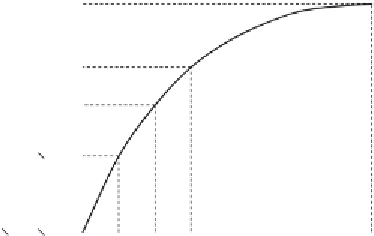Civil Engineering Reference
In-Depth Information
Load
P
total
P
3
P
2
P
1
u
1
u
2
u
3
u
total
Displacement
Figure 5.29 Load-displacement history in a nonlinear analysis.
The analyses can be linear or nonlinear and assume that time-dependent
material effects, such as creep, are negligible. Linear static analysis involves
the specification of load cases and appropriate boundary conditions. If all or
part of a structure has linear response, substructuring is a powerful capability
for reducing the computational cost of large analyses. Static nonlinear ana-
lyses can also involve geometric nonlinearity and/or material nonlinearity
effects. If geometrically nonlinear behavior is expected in a step, the
large-displacement formulation should be used. Only one procedure is
allowed per step and any combination of available procedures can be used
from step to step. However, information from a previous step can be
imported to the current step by calling the results from the previous step.
The loads, boundary conditions, and output requests can be inserted in
any step.
Most available general-purpose finite element computer programs clas-
sify the steps into two main kinds of steps, which are commonly named as
general analysis steps
and
linear perturbation steps
. General analysis steps can be
used to analyze linear or nonlinear response. On the other hand, linear per-
turbation steps can be used only to analyze linear problems. Linear analysis is
always considered to be linear perturbation analysis about the state at the
time when the linear analysis procedure is introduced. The linear perturba-
tion approach allows general application of linear analysis techniques in
cases where the linear response depends on preloading or on the non-
linear response history of the model. In general, analysis steps and linear















Search WWH ::

Custom Search